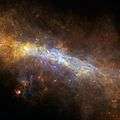Great Rift (astronomy)

In astronomy, the Great Rift (sometimes called the Dark Side, Dark Rift, or, less commonly, Dark River) is a series of overlapping, non-luminous, molecular dust clouds that are located between the Solar System and the Sagittarius Arm of the Milky Way Galaxy at a distance of about 100 parsecs or about 300 light years (2×1015 miles or 3×1015 kilometers) from Earth. The clouds are estimated to contain about 1 million solar masses of plasma and dust.[1]
Properties
To the naked eye, the Great Rift appears as a dark lane that divides the bright band of the Milky Way lengthwise, through about one-third of its extent, and is flanked by lanes of numerous stars.[1]
Starting at the constellation of Cygnus, where it is known as the Cygnus Rift or Northern Coalsack, the Great Rift stretches to Aquila; to Ophiuchus, where it broadens out; to Sagittarius, where it obscures the Galactic Center; and finally to Centaurus. One of the most important regions it obscures is the Cygnus OB2 association, a large cluster of young stars and one of the largest regions of star formation near Earth. A similar dark band can be seen in edge-on distant galaxies, such as NGC 891 in Andromeda.[2]
Gallery
-

Wide angle view the Milky Way near the Cygnus constellation showing the dark lane of the Great Rift.
-

Milky Way Image showing the dusty lanes dotted with colorful nebulae between Sagittarius to Scorpius.
-

Radio image showing intense radio emissions emanating from the center of the Milky Way.
-

View of the Milky Way and the Great Rift from ESO's Very Large Telescope in Cerro Paranal, Chile.
-

Mysterious ring composed of very dense and cold gas and dust at the center of the Milky Way.
-

Image showing the dense and compact regions where gas and dust clump together in the galaxy.
See also
Notes
- 1 2 Great Rift: Dark area in the Milky Way 2010 EarthSky Communications. Accessed June 2010
- ↑ Pitts, Sam. "NGC 891 Edge on Galaxy (HV19)". Sams Astro. Retrieved 2009-04-25.
References
- "The Great Rift". Encyclopædia Britannica Online. 2009. Retrieved 2009-04-25.
- "Great Rift". Sci-Tech Dictionary:. Retrieved 2009-04-25.
- Kaler, Jim. "The Milky Way - From STARS". University of Illinois at Urbana-Champaign. Department of Astronomy. pp. Maps 2 and 5. Retrieved 2009-04-25.
- NASA Astronomy Picture of the Day: Dark River, Wide Field (19 July 2010)